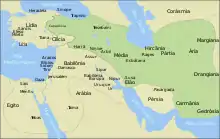Kurdish calendar
The Kurdish calendar[1][2][3][4][5][6][7] is a calendar used in the Kurdistan region of Iraq alongside the Islamic and Gregorian calendar.[8]

History
The start of the calendar is marked by the Battle of Nineveh, a conquest of the Assyrians by the Medes and the Babylonians in 612 BC.[1][2][4][5]
Although the calendar is officially adopted in Iraqi Kurdistan its use is limited. Kurds in Iran use the calendar extensively as it is nearly identical to the Iranian Calendar. The calendar is not used by Kurds in Turkey and Syria as it is associated with Kurdish Nationalism and clashes with the official state calendars.[9][10]
Details of the Kurdish calendar
The calendar is made to fit into society's constructions by being divided into two seasons (summer and winter). The year is divided into four seasons consisting of 12 weeks with each week having seven days.[7] Months that fall into the summer season are 31 days long while months that fall into the winter season are 30 days long. The exception to this is the last month of winter which acts as a leap year and therefore will variate between 29 and 30 days.[7]
Month names
The names for the months are often derived from society's events in that month[7][11]
| Order | Days | Native Script | Romanized | Likely Meaning |
|---|---|---|---|---|
| 1 | 31 | خاکەلێوە | Xakelêwe | |
| 2 | 31 | گوڵان | Gułan | Likely derived from the Kurdish word 'Gul' meaning flower. |
| 3 | 31 | زەردان | Zerdan | |
| 4 | 31 | پووشپەڕ | Pûşpeř | |
| 5 | 31 | گەلاوێژ | Gelawêj | Named after the Gelawêj star that becomes visible in this month. |
| 6 | 31 | خەرمانان | Xermanan | Likely derived from the word Kurdish word 'Xerm' meaning warm. |
| 7 | 30 | بەران | Beran | |
| 8 | 30 | گێزان | Xezan | |
| 9 | 30 | ساران | Saran | |
| 10 | 30 | بەفران | Befran | Likely derived from the word 'Befr' meaning snow. |
| 11 | 30 | ڕێبەندان | Řêbendan | |
| 12 | 29/30 | ڕەشەمە | Řeşeme |
References
Citations
- Kirmanj, pp. 367–384.
- Hirschler 2001, pp. 145–166.
- Rafaat, pp. 488–504.
- Elis, pp. 193.
- Gunter, pp. 191–209.
- Leary 2005, p. 176.
- Izady 1992, p. 241.
- Kirmanj, pp. 372–373.
- Izady 1992, p. 242.
- Izady 1992.
- Roshani 2004.
Bibliography
- Elis, Hadi (2004-06-20). "The Kurdish demand for statehood and the future of Iraq". The Journal of Social, Political, and Economic Studies. 29 (2): 191–209.
- Gunter, Michael (1995). "The Kurds: A Contemporary Overview/No Friends But the Mountains: The Tragic History of the Kurds/The PKK: A Report on Separatist Violence in Turkey, 1973-1992/The Kurdish Tragedy". The International Journal of Kurdish Studies. 8 (1/2): 133.
- Hirschler, K. (2001). "Defining the Nation: Kurdish Historiography in Turkey in the 1990s" (PDF). Middle Eastern Studies. Informa UK Limited. 37 (3): 145–166. doi:10.1080/714004406. ISSN 0026-3206. S2CID 59445286.
- Kirmanj, Sherko (2014-07-15). "Kurdish History Textbooks: Building a Nation-State within a Nation-State". The Middle East Journal. 68 (3): 367–384. doi:10.3751/68.3.12. ISSN 0026-3141. S2CID 144636394.
- Leary, Brendan (2005). The future of Kurdistan in Iraq. Philadelphia: University of Pennsylvania Press. ISBN 978-0-8122-1973-9. OCLC 57001883.
- Rafaat, Aram (2016-03-07). "The fundamental characteristics of the Kurdish nationhood project in modern Iraq". Middle Eastern Studies. Informa UK Limited. 52 (3): 488–504. doi:10.1080/00263206.2015.1124415. ISSN 0026-3206. S2CID 147220842.
- Roshani, Dilan. "Kurdish calendar". Kurdistanica. www.kurdistanica.com. Archived from the original on 2008-02-22. Retrieved 19 April 2020.